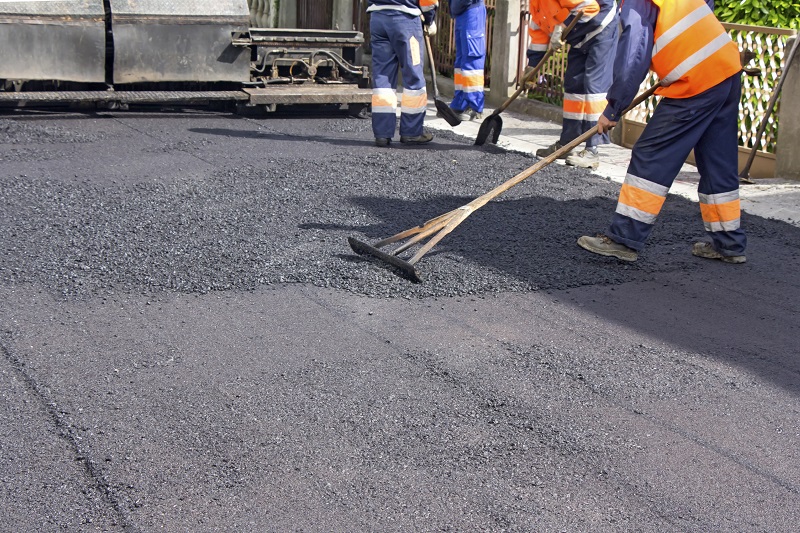Reimagine Your Room: Hot Mix Asphalt Paving for Angled Parking Lot Jobs
Reimagine Your Room: Hot Mix Asphalt Paving for Angled Parking Lot Jobs
Blog Article
Unlocking the Tricks of Hot Mix Asphalt Modern Technology
Checking out the depths of hot mix asphalt modern technology discovers a world where accurate formulations and precise procedures assemble to shape our roadways and facilities. The blend of binders, accumulations, and fillers isn't merely a building and construction job but a critical orchestration of longevity and efficiency. As we peer into the detailed dancing of parts, a tapestry of strength and sustainability unravels. What lies beneath this surface of asphaltic mastery, and what secrets wait to be introduced in the world of paving technologies?
Importance of Warm Mix Asphalt
Hot Mix Asphalt plays a vital duty in contemporary facilities advancement due to its sturdiness and cost-effectiveness. As the most commonly used leading material for roads, highways, and parking great deals, Warm Mix Asphalt supplies a variety of benefits that add to its value in construction projects.
The toughness of Hot Mix Asphalt originates from its composition, which consists of aggregates, binder, and filler materials that are meticulously selected and blended to satisfy particular performance requirements. This exact mix results in a solid and adaptable pavement that can sustain constant usage without substantial deterioration. Moreover, Warm Mix Asphalt is 100% recyclable, additional boosting its sustainability and ecological benefits. Overall, the relevance of Warm Mix Asphalt in facilities growth can not be understated, as it continues to be a cornerstone of modern-day building techniques.
Components of Asphalt Mixes
The structure of asphalt mixes includes thoroughly picked accumulations, binder, and filler materials that are crucial for attaining specific performance requirements. Accumulations are the main component of asphalt mixes, supplying stamina and stability. These aggregates can be natural, such as gravel or crushed rock, or artificial, like recycled products from old sidewalks. The binder, typically bitumen or asphalt concrete, holds the aggregates with each other and offers versatility and sturdiness to the mix. The option of the binder is crucial as it directly affects the mix's performance in different climate conditions. Fillers, such as moisturized lime or Rose city concrete, are used to improve the mix's workability and aging resistance. Angled Parking.
The combination and proportion of these components play a considerable duty in identifying the quality and performance of the asphalt mix. Designers thoroughly create the mix to satisfy particular needs, taking into consideration variables like web traffic quantity, climate problems, and pavement lifespan. Correct choice and balancing of aggregates, binder, and fillers are important for developing durable, resilient asphalt sidewalks.
Mixing and Manufacturing Strategies

As soon as the aggregates are selected, the binder, often asphalt concrete, is contributed to bind the products with each other. The binder's quality and amount substantially influence the mix's flexibility, resistance, and stamina to ecological factors. In addition, fillers like hydrated lime or Portland concrete might be included to boost specific characteristics of the asphalt mix, such as its workability or moisture resistance.
During production, the accumulations and binder are heated, normally in between 250-325 ° F(121-163 ° C ), to help with mixing and make certain proper coating of the accumulations. The blending process should be thorough to achieve a homogeneous mix that promotes the desired performance characteristics of the asphalt. Numerous strategies, such as batch blending or drum mixing, are employed to achieve high-quality and consistent asphalt blends for building and construction jobs.
Aspects Affecting Asphalt Performance
Variables influencing asphalt performance include a range of variables that influence the durability, long life, and general high quality of asphalt sidewalks. One crucial factor is the quality of products made use of in the asphalt mix.

Ecological problems also affect asphalt performance. Temperature variants, wetness infiltration, and web traffic lots can all impact the architectural integrity of the sidewalk. Style factors to consider, such as pavement density and water drainage, are vital in more helpful hints making sure the lasting performance of the asphalt pavement. By carefully taking into consideration these professionals, engineers and factors can optimize asphalt performance and boost the solution life of pavements.
Lasting Practices in Asphalt Technology

WMA permits for the production and positioning of asphalt mixes article source at lower temperatures compared to typical hot-mix asphalt, resulting in minimized power usage and greenhouse gas emissions. The use of permeable asphalt blends can assist reduce stormwater overflow issues by allowing water to infiltrate with the sidewalk and into the ground, promoting natural water filtration and charge processes.
Verdict
Finally, warm mix asphalt innovation plays a crucial function in modern facilities advancement due to its toughness and cost-effectiveness. By carefully stabilizing components, employing appropriate mixing methods, and considering different variables, designers can develop top notch asphalt blends that hold up against heavy traffic tons and harsh climate condition. Welcoming lasting methods, such as using recycled materials and warm-mix technologies, even more improves the ecological friendliness of asphalt innovation.
Blending and manufacturing techniques in warm mix asphalt modern technology entail the precise combination and handling of accumulations, binder, and fillers to develop a high-performance and sturdy asphalt mix.Factors influencing asphalt efficiency encompass a range of variables that influence the sturdiness, longevity, and total quality of asphalt sidewalks. Lasting methods in asphalt innovation encompass numerous efforts intended at lowering the ecological influence of asphalt production and paving procedures. By integrating reclaimed asphalt sidewalk (RAP) and recycled asphalt roof shingles (RAS) right into new asphalt mixes, the use this link sector can substantially decrease the intake of raw products and power, while likewise lowering land fill waste.
WMA enables for the production and placement of asphalt mixes at lower temperature levels compared to standard hot-mix asphalt, resulting in reduced power intake and greenhouse gas emissions.
Report this page